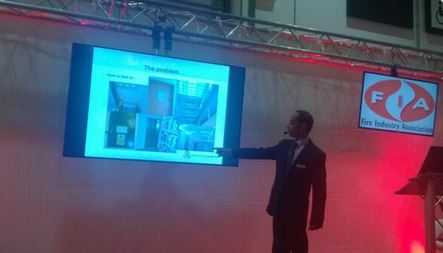

Despite the cleaning product lingo the device is promoted by Sukhi Dhillon of Detectortesters as a cost saving, regulation compliant and potentially life saving appliance in the fire detection industry. “The Scorpion has been proven to be cost effective within two years of use”, said Dhillon.
Speaking at the FIREX exhibition at the Excel centre Dhillon confidently explained the problems that arise from the location of fire and smoke detectors. Lift shafts, stairwells, modern open plan office complexes were shown as examples of hazardous spaces.
Dhillon explained that the fundamental issue faced by those who have to maintain and check equipment is the fact that they are obliged by law to check 100% of detectors. This is irrespective of the location of the detectors or indeed the difficulty involved in getting to them.
The Scorpion is a tool that can help you achieve full compliance by making difficult-to-reach smoke detectors
as easy to test as any standard detector. Awkwardly placed smoke detectors have hitherto been problematic in terms of dealing with insurance companies and the courts.
Dhillon was effective in relaying the limitations of current solutions with height regulations and the need to burn materials and induce smoke to identify the location of certain detectors.
How does the Scorpion Work?
Scorpions are permanently installed, and are fitted adjacent to the detector they are to test. They use their own cabling and remain discrete from the fire detection system.
Scorpion heads connect to a Control Panel, which is the point at which the Service Engineer interfaces with the Scorpion system.
Major Feature
Each Control Panel controls up to eight Scorpion heads located up to 100 metres away depending on cable type used.
Solutions
Distance – A range of 100 meters allows for tricky places to become accessible
Time- Testing capacity is in excess of 240 tests of 15 seconds per head
Cost – No access equipment or various people (lift engineer, fire engineer) needed to complete process which saves operational costs.
Efficiency- “Previously lifts, stairwells would have to become un-operational for half a day up to a day which could be potential fire hazards in their own right.
Subscribe to the IFSEC Insider weekly newsletters
Enjoy the latest fire and security news, updates and expert opinions sent straight to your inbox with IFSEC Insider's essential weekly newsletters. Subscribe today to make sure you're never left behind by the fast-evolving industry landscape.
Sign up now!